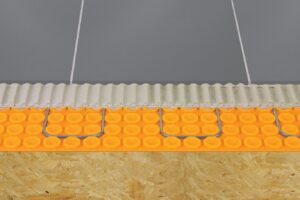You living in Bellevue, Seattle, Sammamish or in any PNW Cities and trying to make your cold rainy days as warm as you can and want to use Floors Warming System to get maximum benefits from it? Let’s talk why is better DO NOT USE LVP or LVT with Floors Warming System.
Luxury Vinyl Planks (LVP) or Luxury Vinyl Tile (LVT) have gained popularity in recent years due to their versatility and cost-effectiveness. They are considered a popular choice for homeowners who want to give their homes a modern look without breaking the bank. However, installing LVP over a warming floor system is not a good idea, and in this article, we will explore the reasons why.

First, let’s define what a warming floor system is. It is a type of radiant heating system that uses electric cables or hot water pipes to heat the floor from underneath. The purpose of this system is to provide warmth to the floor and the room. This type of system is commonly installed in bathrooms, kitchens, and other areas where people tend to spend a lot of time barefoot.
Now, let’s take a look at why it’s a bad idea to install LVP over a warming floor system:
- LVP is not a good conductor of heat: One of the primary reasons why LVP is not a good choice for use with a warming floor system is that it is not a good conductor of heat. LVP is made of PVC (polyvinyl chloride), which is not a good conductor of heat. Therefore, it takes longer for the heat to pass through the LVP, resulting in inefficient heat transfer. This means that the room will take longer to heat up, and you will end up spending more money on electricity bills.
- LVP can warp and buckle: Another issue with LVP over a warming floor system is that it can warp and buckle. LVP is designed to expand and contract slightly in response to temperature changes. When it is installed over a warming floor system, the constant heating and cooling can cause the LVP to expand and contract excessively, leading to warping and buckling. This can create an unsightly and uneven surface that is uncomfortable to walk on.
- LVP adhesive can fail: The adhesive used to install LVP can also fail when exposed to constant heat. The adhesive can soften and lose its grip on the subfloor, causing the LVP to lift and shift. This can create gaps between the planks, which can be a tripping hazard and collect dirt and debris.
- Warranty concerns: If you install LVP over a warming floor system, it may void the warranty on both the LVP and the warming floor system. Manufacturers of both products have specific guidelines for installation and use, and failure to follow these guidelines can lead to warranty issues.
In conclusion
While LVP is a popular choice for homeowners, it is not a good idea to install it over a warming floor system. The combination of LVP’s poor heat conductivity, tendency to warp and buckle, adhesive failure, and potential warranty issues make it a less than ideal choice for use with a warming floor system. If you are looking for an alternative to LVP, consider hardwood flooring. At LUKS CONSTRUCTION, we specialize in hardwood flooring installation and can help you find the perfect solution for your home. Contact us today to learn more about our services in Bellevue and Seattle area. Give us a call today and we will provide FREE on-site consultation!





